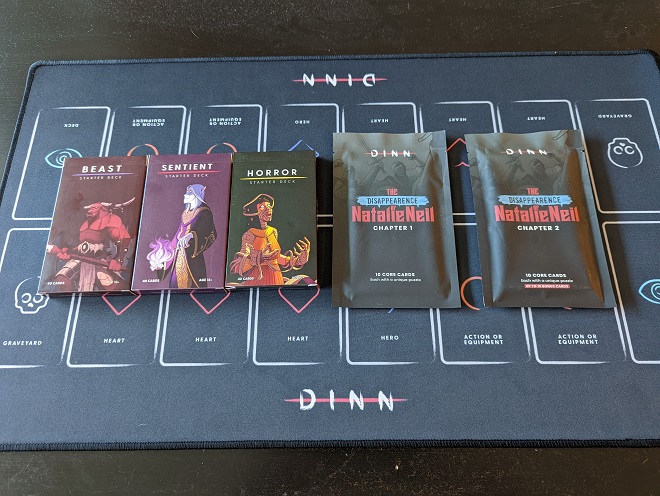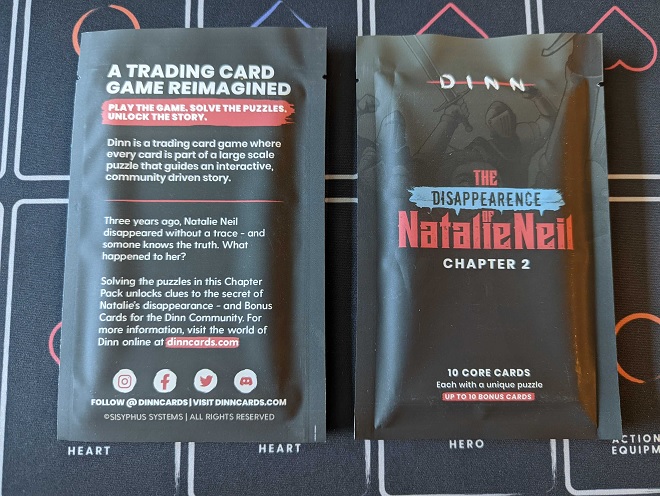
In 2017, the computer programmer Natalie Neil disappeared without a trace from the quaint town of Rock Springs, Wyoming. Despite making national news and triggering a statewide search, Natalie appeared to have vanished without a trace, and the investigation was closed. But recently, individuals close to the investigation started receiving mysterious packages in the mail, containing a USB drive with an old voicemail message from Natalie, and a personalized decks of cards.
- Charlie Neil, Natalie’s sister, received a deck of cards pulled straight from Arthurian legend, featuring figures of myth and legend;
- Don Horn, the detective who investigated Natalie’s disappearance before getting pulled off the case, received a deck of cards with more beastly and animalistic attributes;
- Ava Whitehall, Natalie’s former boss at Whitehill Mining, received a deck with a more demonic bent.
All told, six people close to Natalie received these mysterious packages. And buried within those decks just might lie the secret behind The Disappearance of Natalie Neil, the first season of the trading card game Dinn. By following along with the investigation through Dinn‘s alternate reality game embedded into the cards players can unravel the mystery themselves, and even exert a degree of influence over the story’s progression.

Deconstructing Dinn: A Brief Overview of the Card Game
On its face, Dinn is a relatively fast-paced trading card game for two players. The goal of the game is to shatter the opponent’s three heart cards by defeating their heroes. Weaker heroes may only shatter one heart when defeated, while more powerful heroes end the game upon a loss, while equipment and action cards are played to give heroes an edge in the battle.
While many trading card games rely on asynchronous gameplay where players take turns driving the action, with Dinn players make their choices simultaneously. Every round starts with both players selecting a hero, and placing them face down on the table. Both players then reveal their hero cards, before activating any abilities written on the card. The process repeats two more times for action and ability cards placed face down, before determining which hero emerges triumphant.

Themed starter decks provide pre-constructed decks that allow players to start playing immediately, while “chapter pack” expansions provide players with additional cards they can integrate into their decks to level up the gameplay experience. There are no card rarities in Dinn: buying a starter deck or expansion pack gets players all the cards in that set, similar to the model used by Fantasy Flight Games with their “Living Card Games”, where seasonal releases give players full access to the game’s card evolving card library.
The Story Behind the Cards: Dinn’s “Artificial Reality Game”
The narrative framing for Dinn is that each of the six “starter decks” of cards in the game are associated with one of the key figures associated with Natalie Neil’s disappearance, and represent a facsimile of what those characters actually received. Accordingly, every starter deck has a meta-puzzle scattered across the cards that helps reveal and advance the character’s story.
For instance, solving the puzzle scattered across the cards from Charlie Neil’s “Sentient” deck of cards involved players mapping out the cards that gave a series of alphanumeric characters – adding that text string to the partial URL added to the footer of all the cards in the deck leads players to discovering Charlie’s blog, What’s Wrong with Rock Springs.
In it, Charlie notes that strange things have been happening in the town of Rock Springs for a while, and that her sister wasn’t the first to disappear. A town with a population of ~23,000 people had over 300 of their residents disappear in the last three years alone. Finally, Charlie blogs about receiving the package with her own personal deck of cards, and a USB containing a voicemail from Natalie, shortly before her disappearance. If players check out Charlie’s “Contact” page, they can register the fact that they solved the puzzle (with the first to solve celebrated for the feat on Dinn‘s website), and even vote on how the story should progress.

This is where Dinn‘s “artificial reality game” comes in. Unlike many alternate reality games where players exist as an entity within the story universe, Dinn is a story centered around the six key figures: player involvement through these votes effectively serves as nudging the hands of fate.
While starter decks deliver single puzzles that span multiple cards across the deck and come bearing the potential to nudge the narrative direction moving forward, chapter pack expansions are more centrally focused on puzzles confined to a single card, that help flesh out the overarching narrative. For instance, the card “Joyeuse” leads players to discover Rock Springs’ automated coffee shop: and using the password from the card unlocks a Customer Assurance recording of Charlie Neil and Detective Don Horn at the cafe that pays off the narrative choice players made during the first puzzle.

Solving these chapter pack puzzles also have a direct impact on gameplay, as every solved card unlocks a “bonus card” in the next chapter’s release for that archetype’s deck. Since all ten puzzles from Chapter 1 were solved, Chapter 2 delivered twice as many cards, as thanks.
Even better: after the puzzles are solved, the Dinn team posts images of the cards and walkthroughs of the solves on the website, so the story and alternate reality gaming component can be experienced even without buying the cards. The advantage of buying the cards is receiving high resolution digital versions of the cards for solving on launch day, and the thrill of trying to solve the cards before the official explanations are released.

Drawing on a Legacy of TCGs Playing at the Intersection of Puzzle and Narrative
Dinn has found a novel way to breathe life into their card game through alternate reality gaming elements scattered throughout the game’s cards. And hopefully, it will help revive the legacy of card games letting players play with card games on multiple levels.
Within the alternate reality gaming arena, it’s almost impossible to talk about Dinn without also mentioning its predecessor Perplex City. When Mind Candy released their first set of puzzle cards in 2005, the game came with a call to action: the Receda Cube has been stolen from an alternate universe and hidden somewhere in our world. Perplex City‘s puzzle cards were designed by Perplex City Academy head Sente Kiteway to help players acclimate to their universe’s puzzle-centric way of thinking, to better recover the Cube.
With Perplex City, there was no traditional card game to serve as its core – players could treat the game as a series of individual puzzle challenges. Thanks to resources like the Perplex City Card Catalog players didn’t need to buy cards to engage with the full experience, but players who wanted to compete for spots on the game’s leaderboard by solving puzzles used the cards’ unique scratch-off codes to confirm ownership of the cards.
While Perplex City created one of the most direct legacies leading to Dinn, the legacy of Legend of the Five Rings runs just as strong. For the first few years of the game’s existence, it was a card game operating on a deadline: player factions competed at their local game stores in competitive “storyline tournaments” to influence the narrative and their faction’s honor. Elements of player wins and losses would be incorporated into future set releases, culminating in a narrative finale at GenCon 1997 known as “The Day of Thunder”, where a player tournament decided the fate of the game. Matthew Colville posted an oral history of that tournament and the events leading up to it on his YouTube channel.

Like Perplex City, the cards in Dinn provide a narrative justification for why the game’s cards would exist. But while Perplex City went the extra step of making sure those cards crossed over from their universe into our own, the walls between our reality and the alternate universe Dinn occupies seem to be made of stronger stuff. However, Dinn‘s design also allows for a more direct relationship between solving puzzles and unlocking narrative and lore. While many Perplex City puzzle cards rewarded players with points on the leaderboard for successfully solving challenges, Dinn ensures that every puzzle solved comes with another piece of the broader narrative, and sometimes even the ability to influence how that narrative progresses.
That narrative influence is something that was core to Legend of the Five Rings‘ early development: and while the mechanism for exerting that influence in Legend of the Five Rings was winning tournaments, Dinn turns to solving puzzles as a mechanism to unlock both content and additional cards. When Legend of the Five Rings “unlocked” new cards based on player contributions, it was typically a direct continuation of the narrative, translated into card form. Dinn has more narrative separation between gameplay and story, so that translation isn’t quite so direct: the cards may exist in The Disappearance of Natalie Neil‘s universe, but there has been no indication so far that the gameplay elements have also crossed over. However, that just means the interplay between card and puzzle is more nuanced. For one particularly interesting puzzle card from the chapter 2 pack, lore introduced on a website uncovered from a prior starter deck puzzle was both used to solve the new puzzle and partially explain what characters found in the storyworld.
Getting Into Dinn: Where to Go For More Answers
If you’re interested in looking into past puzzles and narrative drops, Dinn‘s page for season 1 provides links to the solutions for all starter deck puzzles, as well as the ten initial puzzles for chapter 2. The puzzle solution for Charlie Neil’s Sentient deck is a particularly creative example of the potential of starter deck puzzles while Final Strike and Devil’s Snare are interesting examples from the first chapter pack.
If you’re interested in learning more about gameplay of the card game itself, the Dinn‘s rules page has a more robust explanation of how to play. The team behind Dinn is currently working on rules for a 4-player mod for the game.
Physical copies can be purchased on the Dinn website’s online store and at select retailers. The game is also available digitally on Tabletop Simulator.
